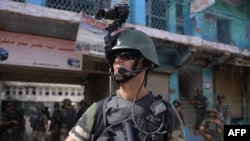Weeks after its launch, a Pakistani military offensive in a northwestern region appears to have had little impact on dismantling Taliban and allied extremist groups.
Since the start of the campaign in mid-June, the Pakistani military claims to have killed more than 400 militants, while at least 20 government soldiers have died in the operation, named “Zarb-e Azab.”
But observers and civilians say the operation has yet to achieve results beyond the body count.
North Waziristan is part of Pakistan's restive northwestern tribal region where, for more than a decade, Islamabad resisted mounting a full-fledged offensive against scores of jihadist factions including Al-Qaeda, the Pakistani and Afghan Taliban, and Central Asian extremists.
Latif Afridi, a senior politician from the tribal areas, told RFE/RL's Gandhara website that the Islamic Movement of Uzbekistan, the operation’s main target, appears to have relocated to the Tirah valley in the Khyber tribal district, 200 kilometers to the north, before the offensive began.
"In North Waziristan it is common knowledge that most militants had slipped out of the region before the operation began," he said. "Some went to Tirah, while others apparently headed to neighboring Kurram and Orakzai tribal districts and other regions in Pakistan and Afghanistan."
Afridi believes that the offensive was aimed at getting $300 million from Washington in Coalition Support Funds. A June amendment by Senator Carl Levin to the National Defense Authorization Act for 2015 requires the U.S. Secretary of Defense to certify that "Pakistan has undertaken military operations in North Waziristan" to disrupt the Afghan Taliban's powerful military wing, the Haqqani network.
"The Taliban, the Haqqani network, and Al-Qaeda seem to have evaded any major damage from the operation. They seem to be preserving their capacity for a future fight," Afridi said. "All this gives the residents of North Waziristan strong reasons to doubt that the operation will end militancy in their homeland."
The offensive has displaced more than 800,000 North Waziristan residents who now face an uncertain future in Afghanistan and Pakistan.
Malik Pai Muhammad, a tribal leader from North Waziristan, said that the offensive has so far mostly harmed civilians. "Our children and women have died inside their homes because of this offensive. All this is very cruel."
Nizam Daur, another resident of North Waziristan, is suspicious about the timing of the military offensive, which came in summer, just before the holy month of Ramadan, when adult Muslims abstain from eating and drinking from dawn until dusk.
"These militants were tormenting us for nearly 13 years, but our security forces failed to move against them," he said. "They regulated social life and collected taxes from businesses, but the government did nothing to stop them."
North Waziristan, spanning nearly 5,000 square kilometers, is strategically located next to the southeastern Afghan provinces of Khost, Paktika, and Paktia. The region, collectively called Loya Paktia, was historically considered the main recruiting ground for the Afghan army.
The region was also the key theater of the anti-Soviet, Afghan guerilla commander Jalaluddin Haqqani, who was based in North Waziristan's administrative capital, Miran Shah.
Haqqani, a key ally of the Pakistani military, retained his base after joining the Taliban regime in the 1990s. After 9/11 his sons and relatives controlled the most potent Taliban network from their base in North Waziristan. Islamabad resisted Western pressure to go after the Haqqanis for years.
Islamabad often cited a 2006 agreement it had concluded with some North Waziristan Taliban factions as the main reason for not confronting the militants. In addition, security analysts argued that an offensive there would exceed the capacity of the security forces.
But Athar Abbas, a former Pakistani military spokesman, claims that in 2010 former Army Chief General Ashfaq Parvez Kayani was reluctant to launch a North Waziristan offensive because he feared a backlash from Pakistan's powerful religious political parties.
Three weeks into the offensive, General Raheel Sharif, the current head of the Pakistani army, has called on his men "to eliminate all local and foreign terrorists and their sanctuaries" in North Waziristan, and hunt them down "across the country till their final elimination."
But critics doubt the Pakistani military would abandon its longstanding policy of pursuing only those militant groups that threaten its security, while turning a blind eye, or even supporting, those that mostly launch attacks inside Afghanistan and India.
Ayaha Siddiqa, an independent Pakistani security affairs expert, recently concluded that the operation is unlikely to target the Haqqani network and other Taliban groups that are not keen on fighting the Pakistani military.
"Many believe that the fundamental pattern of playing the 'good' versus 'bad' Taliban game persists," she noted. "Segments of society are deeply worried that such a half-baked plan may make Pakistan unstable in the future."
Christine Fair, a security affairs professor at Washington's Georgetown University, observed that the Pakistani army is unlikely to cease supporting "a menagerie of Islamist militants operating in and from Pakistan."
Fair believes that the residents of North Waziristan will pay a high price for the Pakistani military's double game. "We’ve seen this show before. And it never has a satisfying ending," she wrote.
Islamabad-based defense analyst Hassan Askari Rizvi said that the eerie silence from the militants casts additional doubt over the military's claims of rapid gains in North Waziristan.
"We have not seen a Taliban counteroffensive in [North] Waziristan or another region," he notes. "This might mean that the military is successful, or that it is exaggerating its modest gains against the militants."








